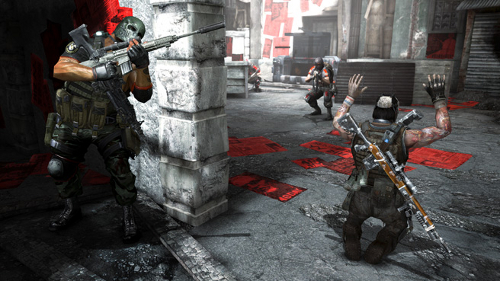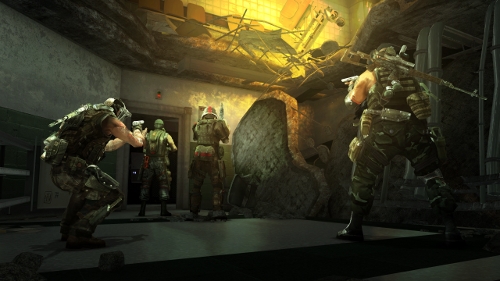
Fake surrendering can be a useful tactic. If you shoot first, however, don't expect the enemy to be fooled by it
Q: I'd like to know more about the co-op playbook. What kind of tools do we have? What kind of interaction? How can we support each other without having to engage some 'move' from the playbook?
A: As Eric mentioned in the interview, the co-op playbook is really set-up as a tool to help get the strategizing/dialogue going between players (or between a player and the A.I.) by showing them what their options are in a given scenario. For players that go through the game co-operatively, it acts as a kind of reminder system that “hey, you can fake surrender in this situation if you want.” For players that go through the game solo and rely upon the A.I. to control their partner, it helps you direct/control the A.I.’s actions. You can issue commands, such as flank these enemies, or take a sniping position, to the A.I., and then reinforce that behavior through high fives, fist bumps, chest bumps, etc. (which you initiate by pressing A on the 360 or X on the PS3 controllers when you’re next to your partner out of combat). Conversely, you can also hit/shove your buddy to indicate that he did something wrong by pressing B or the circle button. Depending on which of these actions you take, you either increase or decrease your camaraderie, however, it’s unclear what kind of impact that has on the game, and the folks from EA Montreal that were at the event weren’t saying just yet.
Q: How much freedom is there in combat situations outside of the co-op playbook (ie. surrendering) and more about tactical options like getting different points of view, explosive barrels, and flanking?
A: There was a question asked about what changed with the environments in this game to “breath more depth into the gameplay” that was asked as well, and the answer I got answers both of these so forgive me for condensing. Essentially, there are often multiple paths that players can take in a given campaign level (although all roads do lead to Rome/the same place, ultimately), and many of the areas where you encounter enemies are open-spaces that allow players to use whatever tactics they choose. Maybe one player attracts all of the attention while the other tries to sneak around behind the enemies to catch them in crossfire. Maybe one player takes an enemy hostage to lure the enemies closer to an explosive barrel that the second barrel explodes with a well-aimed sniper shot. There definitely are a few tactical options available to players outside of the co-op playbook, and it’s up to the players to work out amongst themselves how they want to approach a situation. The GPS system can be used to help scout ahead somewhat to see enemy positions and do some planning.

It's a sneaking mission, if that's how you decide to play it
Q: There's been talk of rewards and that's always great, but what if my co-op partner isn't very cooperatively. In the first game, I had a human partner run off by himself and shout at me to get over there when he inevitably got shot down. Are there penalties for players that put themselves over their partner?
A: A swift death for you both is the answer I got. There are rewards, but no set penalties for players that seem to miss the idea behind co-op gameplay. For the multiplayer mode, Eric told me while there’s a lot in place to encourage players to play together, but they still wanted to keep it open to allow players the freedom to play the game how they chose to play it. While this doesn’t always result in an ideal situation for both players, going a slightly more Draconian route results in the same dissatisfaction for at least one of the players.
Q: Considering the missions in the first game were years apart from each other, how will condensing the story to Shanghai provide better character progression that really makes them characters worth caring about and not just avatars of destruction?
A: Spenser told me that the first game was a little more focused on where Salem and Rios were going and what they were doing than it was about them as characters. That’s changed with the second game and the story has been designed to really focus on them and what they have to do to survive. I don’t want to spoil anything, but I will say that the intro to the game certainly presents them as being a little more vulnerable than we’ve seen them before, and certain other scenes has them flat-out clueless about what to do, so I think EA Montreal has taken steps to create some genuine characters this time around.
Thanks again to you all for the great questions, and hopefully that answers all of them! I was overwhelmed by the response we got to the forum post and the folks from EA were impressed with many of the questions that you all had for them. Our coverage from the Army of Two: The 40th Day Community Event wraps up tomorrow with some hands-on impressions of the PSP title. Before that, though, I have a question for you all: did you ever have a chance to check out The Red Star?